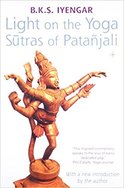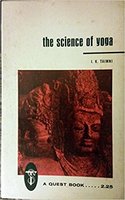ANSWER: Because if you knew what the individual words meant, you might translate the sūtra meanings differently.
Toward the bottom of the page, I share how 7 different very respected authors translate one of my favorite sūtras, which is...
Yoga Sūtra 1.33 and says...
maitrīkaruṇā - muditopekṣāṇām - sukhaduḥkha -
puṇyāpuṇyaviṣayāṇām - bhāvanātaḥ - cittaprasādanam
maitrīkaruṇā - muditopekṣāṇām - sukhaduḥkha -
puṇyāpuṇyaviṣayāṇām - bhāvanātaḥ - cittaprasādanam
...then I share with you how each word is translated individually before offering my overall translation of the sūtraI (you can even click the button below to hear me chant it in Sanskrit). Before you scroll down to get the goods, hear me out on why I hold the position that it's a bad idea to RELY on the translations of authors to learn the Yoga Sūtras of Patañjali.
|
Patañjali’s Yoga Sūtras are a sure bet to total freedom, living a life you most desire, and actualizing your fullest potential. BUT, what if…
…WHAT IF your teacher, translator, or author (someone you trust) happens to be unintentionally wrong OR at least the way they choose to explain the yoga sūtras (or any particular sūtra) is enough to cause you slight confusion, subtle misunderstanding, or lead you a little off track…? I mean, they might understand it just fine in a way that works well for them and their life, but the way they explain and expound the sūtras might not speak to you in a way that’s useful, constructive, or fruitful. Wouldn’t this defeat the purpose of learning the sūtras at all if the intent is for you to be able to apply the practical wisdom of these sūtras in your everyday in order that you may fully experience the highest quality life possible? To help people live life in full bloom, the sūtras are meant to be accurately understood so they may be properly applied. If the sūtras are misunderstood and/or misapplied, this can cause people to come up short of their BEST. For this reason, to RELY SOLELY on the translations of other people is RISKY BUSINESS, and I suspect TOO RISKY for anyone who is “seriously serious” about actualizing their fullest potential. |
|
To illustrate the WHAT IF scenario from above, below I show you how seven different authors -- respected authorities recognized in their field for their work and knowledge of Patañjali’s Yoga Sūtras -- articulate this particular sūtra differently (and this is also true of the rest of the sūtras in the text). Observe how none of them explains the sūtra in "exactly" the same way… they may appear to be close, but not identical. This is because understanding is personal and unique to every individual.
The surest way to ensure you accurately learn the profound practical wisdom of Patañjali’s Yoga Sūtras in your own personal and unique way, is to go straight to the source, or as close as you can get to the source, by learning what the individual words mean (and THIS is precisely why I teach the word-for-word meanings of Patañjali’s Yoga Sūtras... so you’ll be equipped to translate each sūtra in your own words based on your own understanding). |
Each of the people I provide on the list below are well established, world renowned yoga teachers (some alive, and some have passed on). The books listed along with their names contain translations of Patañjali’s Yoga Sūtras.
The example I've chosen to share below is one of my favorite sūtras. To a person versed in the study of Patañjali’s Yoga Sūtras, and has a well developed command of sūtra knowledge, the variances between these interpretations may seem minor; but to the novice just being introduced to the sūtras, these differences in word choice to explain the sūtras can be a major influence over the beginner’s understanding or lack thereof. We must recall that the translator’s choice of words is only representative of their “interpretation” of the sūtras, and when you read their translations, you are essentially compelled to “interpret” their “interpretation” potentially causing you to drift a bit further from the accuracy of the sūtra(s). A safer and much more reliable way to ensure you accurately understand what the sūtras are attempting to convey is to learn what each of the words in the sūtras mean. Then, when you (the student) know what the words mean, you will be able to translate in your own words what each of the sūtras mean based on syntax, context, and the arrangement of the sūtras themselves. In short, by being empowered with a word-for-word breakdown, you may have command over the sūtra meanings and NOT be dependent on the understanding of others.
So, here it is... ONE of my favorite sūtras -- SERIOUSLY! Observe how differently it can be interpreted. I want you to imagine that one of these people is your teacher… Do you think you'll take away the exact same understanding from each of the author’s interpretations? OR does each interpretation speak to you in at least a slightly different way? Keep these questions in mind as you read the following interpretations.
The example I've chosen to share below is one of my favorite sūtras. To a person versed in the study of Patañjali’s Yoga Sūtras, and has a well developed command of sūtra knowledge, the variances between these interpretations may seem minor; but to the novice just being introduced to the sūtras, these differences in word choice to explain the sūtras can be a major influence over the beginner’s understanding or lack thereof. We must recall that the translator’s choice of words is only representative of their “interpretation” of the sūtras, and when you read their translations, you are essentially compelled to “interpret” their “interpretation” potentially causing you to drift a bit further from the accuracy of the sūtra(s). A safer and much more reliable way to ensure you accurately understand what the sūtras are attempting to convey is to learn what each of the words in the sūtras mean. Then, when you (the student) know what the words mean, you will be able to translate in your own words what each of the sūtras mean based on syntax, context, and the arrangement of the sūtras themselves. In short, by being empowered with a word-for-word breakdown, you may have command over the sūtra meanings and NOT be dependent on the understanding of others.
So, here it is... ONE of my favorite sūtras -- SERIOUSLY! Observe how differently it can be interpreted. I want you to imagine that one of these people is your teacher… Do you think you'll take away the exact same understanding from each of the author’s interpretations? OR does each interpretation speak to you in at least a slightly different way? Keep these questions in mind as you read the following interpretations.
|
EXAMPLE: Here's what yoga sūtra 1.33 says...
maitrīkaruṇā - muditopekṣāṇām - sukhaduḥkha - puṇyāpuṇyaviṣayāṇām - bhāvanātaḥ - cittaprasādanam |
Now, here’s how 7 different respected authorities interpret YS 1-33:
|
T.K.V. Desikachar interprets yoga sūtra 1.33 as :
In daily life we see people around who are happier than we are, people who are less happy. Some may be doing praiseworthy things and others causing problems. Whatever may be our usual attitude toward such people and their actions, if we can be pleased with others who are happier than ourselves, compassionate toward those who are unhappy, joyful with those doing praiseworthy things, and remain undisturbed by the errors of others, our mind will be very tranquil. |
|
B.K.S. Iyengar interprets yoga sūtra 1.33 as :
Through cultivation of friendliness, compassion, joy, and indifference to pleasure and pain, virtue and vice respectively, the consciousness becomes favorably disposed, serene and benevolent. |
|
Sri Swami Satchidananda interprets yoga sūtra 1.33 as :
By cultivating attitudes of friendliness toward the happy, compassion for the unhappy, delight in the virtuous and disregard toward the wicked, the mind-stuff retains its undisturbed calmness. |
|
Chip Hartranft interprets yoga sūtra 1.33 as :
Consciousness settles as one radiates friendliness, compassion, delight, and equanimity toward all things, whether pleasant or painful, good or bad. |
|
Gregor Maehle interprets yoga sūtra 1.33 as :
Clarity of the mind is produced by meditating on friendliness toward the happy, compassion toward the miserable, joy toward the virtuous, and indifference toward the wicked. |
|
Swāmi Hariharānanda Āranya interprets yoga sūtra 1.33 as :
The mind becomes purified by the cultivation of feelings of amity, compassion, goodwill and indifference respectively towards happy, miserable, virtuous and sinful creatures. |
|
I.K. Taimni interprets yoga sūtra 1.33 as :
The mind becomes clarified by cultivating attitudes of friendliness, compassion, gladness and indifference respectively towards happiness, misery, virtue and vice. Well, who would you pick as your teacher if you had to choose one? |
|
म्ऐत्रीकरुणा - मुदितोपेक्षाणाम् - सुखदुःख -
maitrīkaruṇā - muditopekṣāṇām - sukhaduḥkha - पुण्यापुण्यविषयाणाम् - भावनातः - चित्तप्रसादनम् । puṇyāpuṇyaviṣayāṇām - bhāvanātaḥ - cittaprasādanam |
|
HERE'S THE WORD-FOR-WORD BREAKDOWN...
maitrī = friendliness; karuṇā = compassion; mercy; mudito = delight; gladness; joy; upekṣāṇām = equanimity; indifference; disregard of; sukha = happiness; joy; duḥkha = sorrow; misery; distress; pain; suffering; unhappiness; puṇya = good; virtuous; virtue; apuṇya = not good (bad); not virtuous (evil); vice; wicked; viṣayāṇām = object (of exp); concerning a thing; bhāvanātaḥ = by dwelling upon in mind; radiating; projecting; by cultivating attitudes; citta = mind; consciousness; prasādanam = undisturbed calmness; tranquilizing; purification; And, here is how I CHOOSE TO EXPLAIN IT IN ENGLISH... THE MIND BECOMES CALM AND TRANQUIL by dwelling upon and projecting attitudes of friendliness, compassion, and delight toward ALL things whether regarded as pleasurable, pain-producing, good, or evil. |
Now that you know what the words mean...
HOW WOULD YOU CHOOSE TO EXPLAIN THIS SŪTRA IN YOUR OWN WORDS?
HOW WOULD YOU CHOOSE TO EXPLAIN THIS SŪTRA IN YOUR OWN WORDS?













